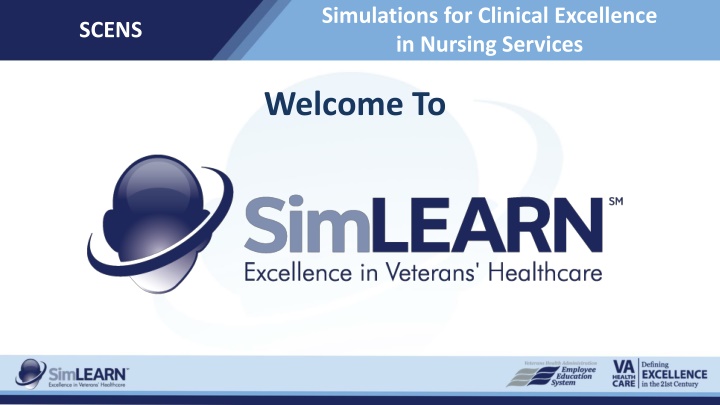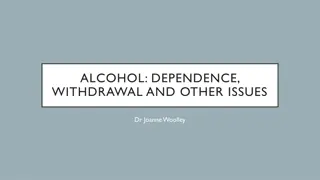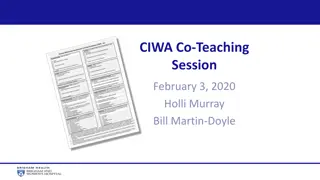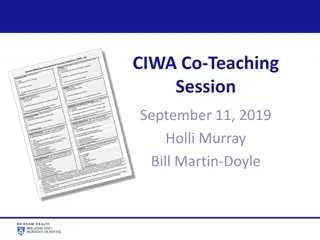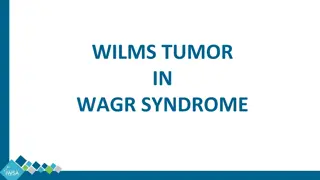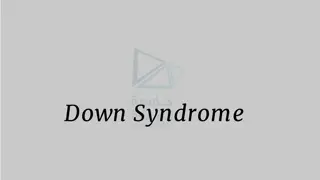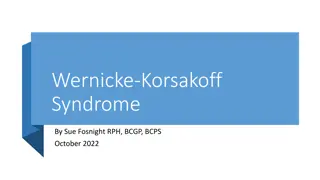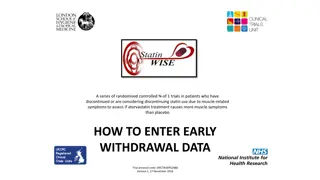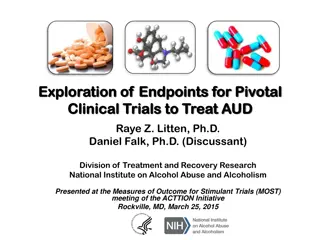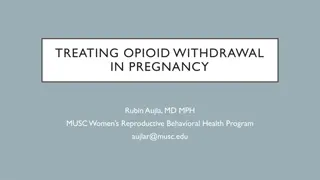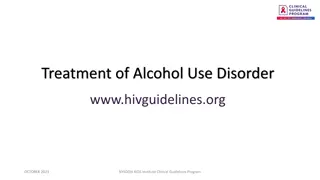Comprehensive Information on Alcohol Withdrawal Syndrome and Clinical Excellence in Nursing Services (SCENS)
Explore the complexities of Alcohol Withdrawal Syndrome (AWS) and learn about managing disruptive patient behaviors during withdrawal scenarios through the Simulations for Clinical Excellence in Nursing Services (SCENS). Discover the significance of establishing safety, implementing assessment protocols, and utilizing effective communication strategies. Gain insights into the severity of AWS symptoms, assessment tools like CIWA-Ar, and the importance of following facility-specific protocols. Enhance your knowledge in nursing practices with SCENS.
Download Presentation

Please find below an Image/Link to download the presentation.
The content on the website is provided AS IS for your information and personal use only. It may not be sold, licensed, or shared on other websites without obtaining consent from the author.If you encounter any issues during the download, it is possible that the publisher has removed the file from their server.
You are allowed to download the files provided on this website for personal or commercial use, subject to the condition that they are used lawfully. All files are the property of their respective owners.
The content on the website is provided AS IS for your information and personal use only. It may not be sold, licensed, or shared on other websites without obtaining consent from the author.
E N D
Presentation Transcript
Simulations for Clinical Excellence in Nursing Services SCENS Welcome To
SCENS Disruptive Patient Withdrawal
Disclaimer SCENS The sensitivity of the content discussed during this scenario may trigger emotional or physiological responses Please inform the faculty if this is uncomfortable for you
Learning Objectives SCENS 1. Establish safety when managing care for the disruptive patient experiencing withdrawal Perform an assessment on a patient exhibiting signs and symptoms of alcohol withdrawal utilizing facility specific assessment tool Implement symptom based withdrawal protocol Utilize effective communication when caring for the disruptive patient experiencing withdrawal 2. 3. 4.
Why? SCENS Joint Commission: 2016 Hospital National Patient Safety Goals Prevention and Management of Disruptive Behavior (PMDB) principles VHA National Patient Safety Improvement Handbook The National Database of Nursing Quality Indicators (NDNQI) VHA Handbook 1160.06
Alcohol Withdrawal Syndrome (AWS) SCENS Caused by the abrupt discontinuance of alcohol 6-96 hours after the last drink Minor symptoms (Initially) Alcoholic hallucinosis (day 1-2) Withdrawal seizures (day 2-3) Delirium Tremens (Day 3-4) Life-threatening complications Seizures Coma Death
Assessment Tool for AWS SCENS Alcohol withdrawal protocol Treat AWS according based on severity of symptoms Can take less than 2 minutes to perform Max score is 67; the higher the score, the higher the severity of symptoms Usually no treatment necessary for score less than 8 Follow facility protocol CIWA-Ar CIWA-An originally 15 item symptom-based assessment scale developed in 1978 Revised to 10 items in 1989; now known as CIWA-Ar Measures severity of AWS Easy to use Widely-accepted and well-validated
Assessment Tips SCENS Nausea or vomiting Anxiety Paroxysmal sweats Tactile disturbances Visual disturbances Tremors Agitation Orientation and clouding of sensorium Auditory disturbances Headache
Symptom Based Alcohol Withdrawal Protocol SCENS History of alcohol use? Has the provider examined the patient? Does the patient have a history of alcohol-related seizures and/or delirium tremens? Initiate symptoms-based alcohol protocol Benzodiazepines (Diazepam or Lorazepam)
Recognize Early Signs of Escalating Behavior SCENS GAINS Mnemonic Gestures Acting Incongruent Noticeable Systematically
Levels of Stress SCENS Normal Moderate Severe Panic
Nursing Considerations SCENS Vital sign frequency Do not wake the patient to administer medication or complete assessment Notify provider if the patient requires 2 or more every hour doses Contact the provider if CIWA score remains unchanged after being medicated
When to Notify the Provider SCENS Temperature above 101 F Systolic blood pressure above 160 mmHg Systolic blood pressure less than 90 mmHg Heart rate greater than 120 Heart rate less than 60 Respiratory rate greater than 24 Respiratory rate less than 10 CIWA greater than 20 points An increase of CIWA score of greater than 10 points Altered mental status Seizures
Facility-Specific SCENS Policies and procedures Protocols Equipment Resources State licensure; scope of practice; certifications; job description Accountability Documentation Disruptive Behavior Reporting System (DBRS)
Priorities for AWS SCENS Recognize escalating behavior Get assistance Safety Prompt diagnosis Anticipate the need for equipment/medications Pharmacologic treatment Management of sedation Mitigation of complications
Potential Issues SCENS Complications Equipment or supplies Medication Delays Transfer to another facility Need for restraints?
Summary SCENS 1. Discussed safety measures when managing care for the disruptive patient experiencing withdrawal Reviewed assessment of the patient exhibiting signs and symptoms of alcohol withdrawal utilizing facility specific assessment tool Discussed symptom based withdrawal protocol Reviewed effective communication when caring for the disruptive patient experiencing withdrawal 2. 3. 4.
SCENS Question Mark
Disruptive Patient (3): Withdrawal SCENS Rolando Jones 49 year old male presents for an appointment for an unknown reason after traveling two hours. He is accompanied by his significant other. Past Medical History: Post Traumatic Stress Disorder (PTSD), type 2 diabetes, chronic obstructive pulmonary disease (COPD), arthritis, diabetic neuropathy, 30 year one pack per day smoking history, and he drinks a few beers a day Past Surgical History: Appendectomy Bilateral lower extremity shrapnel removal Medications: Metformin 500 mg three times daily with meals Lorazepam 2 mg every 8 hours Albuterol/Ipratropium inhaler 2 puffs four times a day Gabapentin 300 mg three times a day Allergies: Dairy products
